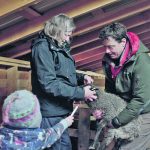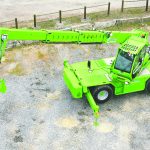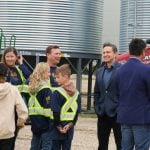
Stories by Freelance writer


Alberta ewe gives birth to rare quintuplets
The extra mouths to feed have increased the amount of work that is required, but the owners feel it is worth it in the end
DAPP, Alta. — Leonard and Twyla Tomlinson, who farm west of Dapp, have raised sheep for 18 years. Twins, triplets, and the occasional quadruplets are pretty normal for them. Their flock average is 2.1 to 2.5 live lambs per ewe. But on April 22 one of their ewes gave birth to five healthy lambs. The […] Read more
Israeli school adds new twist to dairy training programs

Going slow speeds handling process
An Alberta rancher says cattle are better behaved if they can walk into a corral calmly and quietly instead of being chased
Dylan Biggs recognized the benefits of quiet cattle handling early in his career. The Hanna, Alta., rancher learned from Bud Williams, who spent many years in Alberta practising and teaching low-stress methods for moving and sorting cattle. “The first thing that sets the stage for good handling in a corral is how the cattle were […] Read more
Disease screening aims to improve health of wild sheep
Pilot project in British Columbia offers free M. ovi testing in domestic flocks as a way to reduce spread to wild animals
This spring, rather than landfilling or burning their waste wool, domestic sheep producers in the East Kootenays can have it turned into environmentally friendly fertilizer pellets while supporting wild sheep conservation. In an initiative that partners hope will grow to include all wild sheep areas in the province, British Columbia shepherd Jennifer Bowes is spearheading […] Read more
Portable corrals ease handling stress
Facilities can be set up anywhere, even in the middle of a large pasture, but it’s important to handle the cattle properly
Portable corrals can make handling easier when cattle are in large pastures. Dr. Kip Lukasiewicz of Sandhills Cattle Consultants says his early experience with portable corrals occurred when he was in a cow-calf practice at Ainsworth, Nebraska. “We did a lot of pregnancy checking, Bangs vaccinations, etc. with more than 45,000 cows in that practice. […] Read more
Horned cattle may require special chutes
Horns are an asset in the Longhorn, Watusi and Scotch Highlander breeds, but safe handling methods must be found
The handling of horned cattle requires special considerations. Longhorn, Watusi and Scotch Highlander breeds, as well as yaks, can have horns that aren’t easily accommodated in regular cattle chutes. Thus, there are specially designed chutes that are safer for the animals and the people handling them. They include simple panels with horizontal bars so the […] Read more
Handling and sorting can be easy, with or without a corral
Patience, an ability to read cattle and knowing the pastures and terrain can make all the difference when handling cattle
Cattle respond to good handling by becoming easy to manage. If mishandled, they react with suspicion or fear when they see people and become difficult to handle. Consistent, non-confrontational methods can build trust in a herd. Al Fenton of Fenton Herefords near Irma, Alta., has been raising Herefords for decades and has 700 registered cows, […] Read more
Breeder urges producers to reap benefits of hybrid vigour
Montana producer says Charolais has the most potential for crossing because many other European breeds have changed
Crossbred cattle have several advantages over purebreds, especially fertility, longevity, feed efficiency and disease resistance. Buddy Westphal, a Charolais breeder near Polson, Montana, says he is amazed that more ranchers haven’t taken advantage of hybrid vigour. “When I was in college 50 years ago, that was the ‘new’ thing that got me into the Charolais […] Read more



